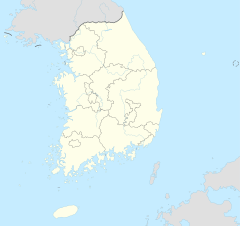Fuyo Jingū
Fuyo Jingū (扶余神宮) was a planned Shintō shrine in Buyeo. It was intended to help with the Japanese occupation of Korea and to be ranked as a Kanpei-taisha. Construction started in 1939 but was never completed.[1][2] It was highly significant in propaganda with many describing it as the second Shintō capital (神都, Shinto[a]) after Ise Grand Shrine.[1]: 151
Buyeo was the capital of Baekje, which had a good historical relationship with Japan. The shrine was intended to mark the permanent incorporation of Korea into Japan[3] under the principle of Naisen ittai (One body of Japan and Korea).[2]
It was built with an intention of being parallel to Kashihara Shrine with materials from all across the Empire of Japan.[1]: 150
Four kami were enshrined there: Emperor Ōjin (Hachiman), Empress Kōgyoku, Emperor Tenji, and Empress Jingū. All were associated with the conquest of Korea. According to legend Empress Jingū delayed her birth to attempt to conquer Korea.[4][2] The design was based on Kashihara Jingū, aiming to be a key Japanese site. Debates arose on which deities to include. Resources from the empire were used in its construction. However, the shrine wasn't completed due to war disruptions.[2] Samchungsa shrine, built in its place in 1957, was dedicated to people who resisted the Japanese conquest.[1]: 224
History
[edit]In 1938, Zenra-nan set up a shrine in each village, the only prefecture to do so. Most shrines worshipped Amaterasu Ōmikami, some with Emperor Meiji. In Zenra-nan, 175 shrines were for Amaterasu and 106 for both Amaterasu and Emperor Meiji. A few in Junten District honored Kunitama.[2]
At first, the Chōsen Governor-General didn't back the one-shrine-per-village idea. But by 1939, he did, leading to more shrines being built. Zenra-nan had the most with 247 shrines.[2] He intended the shrine to rival the Kashihara Shrine 2600th anniversary renovation.[1]: 151
The Chōsen Governor-General wanted to stress Naisen ittai (One body of Japan and Korea). The shrine was to combine Korean traditions with Shintō practices and underline Korea's role in Japanese history. The main deity was Amaterasu, but Fuyo Jingū notably worshipped four kami – Emperor Ōjin, Empress Saimei, Emperor Tenji, and Empress Jingū – significant to Korea.[2]
In 1945 construction ceased, and in 1957 Samchungsa shrine was built in its place, dedicated to three loyal retainers of Baekje who would have fought against Empress Jingū. It used the same materials Fuyo Jingū had been built with.[1]: 224 Samchungsa shrine is within the Baekje Historic Areas, registered in 2015 as a UNESCO World Heritage Site.[5][1]: 224
Integration of Korean customs
[edit]In the 1930s, Korea started blending local customs with Shintō shrines, seen by some as an attempt at assimilation. But this was often hindered by the Chōsen Governor-General. Still, local officials in the 1930s tried connecting Korean communities to shrines, leading to a fusion of Korean and Shintō traditions.[2]
Initially, the Chōsen Governor-General suppressed many Korean customs. But, from 1933, with the Agricultural Village Promotion movement, there was a change. This aimed to transform Korean village shrine sites into Shintō-like sites. Many Korean prefectures began recognizing these sites, merging Korean and Japanese traditions.[2]
While Amaterasu was popular, Korean traditions played a role. Festivals included Korean practices like wrestling. Korean mayors, in traditional outfits, led ceremonies, showing a mix of Japanese and Korean customs.[2]
Notes
[edit]References
[edit]- ^ a b c d e f g Nakajima, Michio (2010). "Shinto Deities that Crossed the Sea: Japan's "Overseas Shrines," 1868 to 1945". Japanese Journal of Religious Studies. 37 (1): 21–46. ISSN 0304-1042. JSTOR 27822898.
- ^ a b c d e f g h i j Shimizu, Karli; Rambelli, Fabio (2022-10-06). Overseas Shinto Shrines: Religion, Secularity and the Japanese Empire. London: Bloomsbury Academic. pp. 145–152. ISBN 978-1-350-23498-7.
- ^ "POINT 정책정보포털". policy.nl.go.kr (in Korean). Retrieved 2023-04-04.
- ^ https://core.ac.uk/download/pdf/151473165.pdf
- ^ "Samchungsa Shrine". UNESCO World Heritage Centre. Retrieved 2023-11-08.


